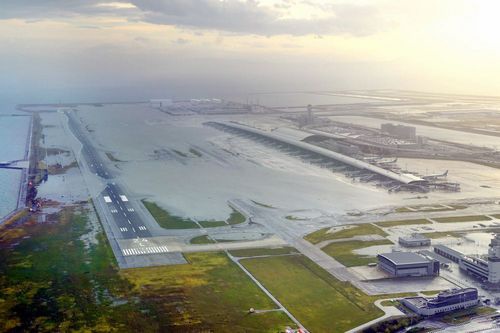
淹水的風險,壟罩低漥地勢的機場
上升的海平面對於高等資產是像威脅
看到這禮拜,關西機場因為燕子颱風襲擊南日本,造成淹水,以及三千多名受困旅客,對於世界各地基礎建設的投資客是項警告。
機場在過去十年被評為高度價值的資產,經營航站的公司的總和市值,像在巴黎、上海、雪梨、法蘭克福、哥本哈根 ,以及泰國,在過去十年幾乎成長四倍,2016年底又成長2/3。
擁有機場是製造長期金流與資產所得萬無一失的保證,當資產在幾十年後租約到期時。這樣的動力來自飛行乘客,未來二十年以每年成長4.7%的幅度成長。泰國機場、雪梨機場、以及奧克蘭機場公司,在該地擁有的企業價值,是臉書、蘋果的十二倍。
這使得這個行業暴露出在面對氣候變化的片段危險,更加不尋常。整個20世紀,對於蓋一座機場要掌握的重點,無非是要大片面積未開發,又負擔得起的平地,靠近大都市。很多情況代表,會蓋在低漥地或甚至是海水填補地,像大阪的關西機場。幾乎照定義來看,世界各地大多數的機場,都蓋在有海平面上升的風險、漲潮、暴風雨、炸雨,或是這四者的總合。
只是到底有多少會受影響很難說,但你藉由觀看關西機場所發生的情形,有個畫面會有多少樞紐受到影響。關西機場在海平面上3.4公尺,跟上海、羅馬一樣。還有布里斯本、巴塞隆納、天津、曼谷、還有阿姆斯特丹都在一樣的高度,有的甚至更低。
類似的洪水會影響到美國47座大型機場的13座,根據美國政府2014年的一份報告。包含紐約都會區的三個主要機場,兩個舊金山,兩個邁阿密以,及費城,華盛頓,新紐奧良,檀香山坦帕,還有聖胡安。
雖然大部分的氣候模型,預測海平面到2100年上升0.2~2 公尺。(平均1公尺)對於機場,主要的風險不是它們會永久性淹水,而是水面上升與更多極端暴雨會造成淹水。之前唯一僅有只發生一次,現在變成經常性的威脅。促使一些資本投入必須花在預防措施,並提高投保金額。不然風險可能會破壞資產價值,造成跌價,最壞的狀況移到更高地勢的地方。
確保資產能對付百年一見的洪水這樣的話,要保持大量質疑。以前預測的一百年模型,跟未來的一百年是非常不同的。美國2012的一份研究發現,紐約市先前預測的洪水,一世紀只會發生一次。現在在氣候變遷的情況下,每二三十年會發生。可以肯定的是,很多機場也許能夠在一些低度氣候改變的預測存活,透過建築物、改良的排水、以及必須基本結構的改建,把它們拉高以跳脫暴風雨的威脅。
在那種情況下,偶爾的洪水會成為低窪機場的職業傷害。發生一次災難,對於依賴它的人會造成巨大干擾。但又不讓他們放棄這個位置。再度地這無法安慰道基礎建設的投資者,他們依賴這些資產長期保值。如果高風險的版本發生,後果是更糟的。
機場擁有者沒有做適當氣候風險模型,或沒有公開,就應該接受投資者的質疑。拒絕討論風險,不代表沒有風險。
Submerged Risks Haunt Low-Level Airports
Rising sea levels are a threat to a highly rated asset class.
By David Fickling
2018年9月6日 上午 04:00
The sight of a flooded Kansai International Airport and 3,000 stranded people after Typhoon Jebi slammed into southern Japan this week should be a warning to the world’s infrastructure investors.
Airports have been a highly rated asset class over the past decade. The combined market capitalization of the companies that run the terminals in Paris, Shanghai, Sydney, Frankfurt, Copenhagen and Thailand has almost quadrupled in the past 10 years, and is up by about two-thirds since the end of 2016.
Owning airports is seen as a surefire way to guarantee long-term cashflows and achieve hefty capital gains when the assets are sold at the end of multi-decade leases, underpinned by air-passenger growth that’s set to run at around 4.7 percent a year over the coming two decades. Airports of Thailand PCL, Sydney Airport Ltd. and Auckland International Airport Ltd. all have enterprise values in the region of 20 times forecast Ebitda, compared with multiples of around 12 times for Facebook Inc., Alphabet Inc. and Apple Inc.
That makes the sector’s patchy disclosure around climate-change risk all the more extraordinary. Through most of the 20th century, the key requirement for building an airport was the availability of a large stretch of undeveloped and affordable flat ground close to a major city. In many cases, that meant building on low-lying marshes, or even reclaimed land as at Osaka’s Kansai. Almost by definition, a large number of the world’s airports are in locations most at risk from rising sea levels, high tides, storm surges, extreme rainfall, or a combination of all four.
Just how many will be affected is hard to say, but you can get a decent picture by looking at how many hubs would be submerged by an event as dramatic as what’s just happened in Japan. Kansai Airport sits about 11 feet (3.4 meters) above sea level. That’s about in line with both of Shanghai’s airports; terminals in Rome, Brisbane, Barcelona, Tianjin, Bangkok and Amsterdam are all of equivalent elevations or lower.
Similar levels of flooding would affect 13 of the largest 47 U.S. airports, according to a 2014 government report, including all three major airstrips in the New York metropolitan area, two around San Francisco and two near Miami, as well as tarmac in Philadelphia, Washington, New Orleans, Honolulu, Tampa and San Juan.
Although most climate models predict between 0.2 meters and 2 meters of sea-level rise by 2100 (with a median estimate of 1 meter), the main risk to airports isn’t that they’ll be permanently submerged. Instead, it’s that elevated waters and more extreme storms cause flooding that had previously happened only rarely to become a regular threats, necessitating increased capital spending on prevention measures and pushing up insurance premiums. That in turn risks undermining valuations, resulting in write downs for the asset owners and in a worst-case scenario the necessity of moving to higher ground.
Assertions that an asset is safe against a 100-year flood event should be taken with a large pinch of salt. The previous 100 years on which those models are based are likely to look very different from the 100 that lie ahead. A 2012 U.S. study found that floods in the New York City area previously expected to occur only once in a century would happen every three to 20 years under climate-change conditions.
To be sure, many airports may be able to survive the lower-end climate-change predictions through a combination of levee building, improved drainage, and rebuilding of essential infrastructure to lift them out of reach of storm surg
In that situation, occasional flooding will become an occupational hazard for major low-lying airstrips — an event that would cause immense disruption to the populations that depend on them, but won’t ultimately lead to the wholesale abandonment of sites. Still, that’s cold comfort to infrastructure investors who are counting on assets to hold their value in the long term — and if the higher-end scenarios come to pass, the consequences could be worse.
Airport owners who haven’t done proper climate risk modelling — or who haven’t publicly released it — shouldn’t be granted the benefit of the doubt by their investors. Refusing to talk about a risk doesn’t make it go away.


 留言列表
留言列表


